Coney
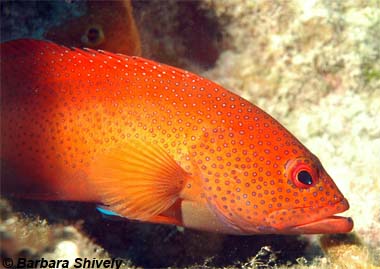
Cephalopholis fulva
This elongated fish has a curved profile and large, round eyes above a pointed snout. It has several striking color phases including bright yellow, red, and bi-colored orange and tan, and usually it has mild to intense amount of speckles on its body. It prefers clear water and deeper reefs where it preys on small fish and invertebrates. As a protogynous species, they all mature as females first, then become males.
Order: Perciformes
Family: Serranidae
Genus: Cephalopholis
Species: fulva
Common Names
English language common names include coney, black guativere, butterfish, deady, lemon-yellow butterfish, negrofish, red guativere, rockhind, small grouper, and yellowfish. Other common names are arigua (Spanish), cabrilla roja (Spanish), caraúna (Portuguese), catoá (Portuguese), catuá (Portuguese), cherna cabrilla (Spanish), coné ouatalibi (French), corruncha (Spanish), fino (Spanish), garoupa (Portuguese), garoupa-chita (Portugese), garoupa-pintada-de-Bahia (Spanish), garoupinha (Portuguese), graniec jasnobrzuchy (Polish), guatibero (Spanish), guativere (French), guativere amarillo (Spanish), jabu (Portuguese), kurakakehata (Japanese), mantequilla (Spanish), mero (Spanish), negrita (Spanish), ouatalibi (French), pirauna (Portuguese), purunchi pretu (Papiamento), rei di punchi (Papiamento), tanche (French), tanche gris (French), and zwarte sproetelvis (Dutch).
Importance to Humans
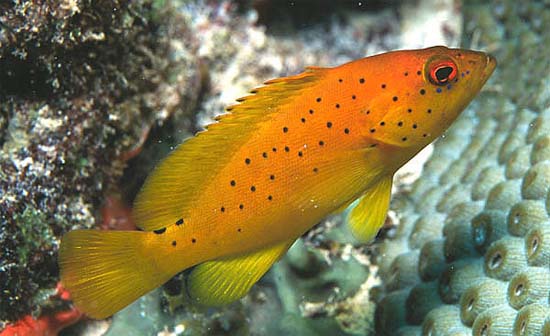
Due to its abundance throughout the West Indies, the coney is often sold for human consumption in local markets. However, due to its small size, it is not of any commercial importance. It is often caught with hook-and-line as well as in fish traps. Caution should be taken as this species has been implicated in cases of ciguatera poisoning. Coneys are often observed by divers and are wary although approachable.
Conservation
The coney is listed as “Least Concern” with the World Conservation Union (IUCN). “Least Concern” is a category given to species that have been evaluated by the IUCN but do not qualify for any other category. The IUCN is a global union of states, governmental agencies, and non-governmental organizations in a partnership that assesses the conservation status of species.
> Check the status of the coney at the IUCN website.
Geographical Distribution
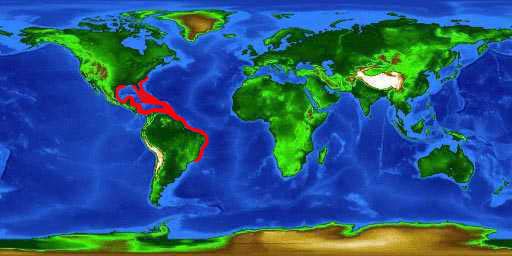
The coney is limited in distribution to the western Atlantic Ocean from South Carolina (U.S.) and Bermuda, south to southern Brazil.
Habitat
Residing among reefs throughout its range, the coney is found at depths ranging from 6- 492 feet (2-150 m), and more commonly to 115 feet (35 m). It prefers coral reefs and clear water conditions. In Bermuda and the West Indies, coneys are commonly observed in shallow waters, hiding in caves and crevices during the day. In the Gulf of Mexico, they prefer high visibility conditions on deep reefs of at least 148 feet (45 m).
Biology
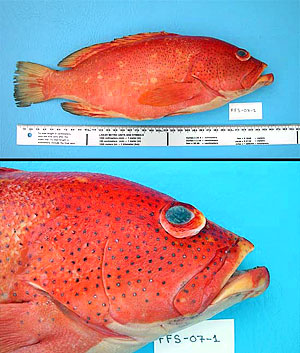
Distinctive Features
The coney has a body depth that is obviously less than the length of the head. The body is oblong in shape and not strongly compressed. The nostrils are small and the jaw extends to or beyond vertical at the rear edge of the eye. The caudal fin is convex along the posterior margin with angular corners. The soft dorsal and anal fins are rounded and the pectoral fins are symmetrically rounded.
This fish is distinguished from other close relatives by the convex rear margin of the caudal fin and its sharp corners. In addition, the two small black spots on top of the caudal peduncle and another two dark blotches at the tip of the lower jaw are distinct characters.
Coloration
The body and fins of the coney’s deepwater phase are red. In contrast, the shallow water phase is orange-brown or bicolored with the upper portion of the fish or normal color and the lower part abruptly pale. In both of the above phases, the head and body has small dark-edged pale blue spots, while in the xanthic phase, they are fewer and confined to the anterior portion of the fish. The xanthic color phase is found in shallow or deepwater and is yellow in color. In all three color phases, there is also a pair of black blotches present on the tip of the lower jaw. The dorsal margin of the caudal peduncle also has two prominent black spots. It is believed that the bicolored phase is in response to excitement and can be activated or deactivated in only a few seconds. At night, the coney is typically a pale fish with irregular vertical bars and a dark tuning-fork mark on the interorbital region similar to that of the Nassau grouper (Epinephelus striatus).
Dentition
There are small canine teeth at the front of the jaws with teeth present on the palatines.
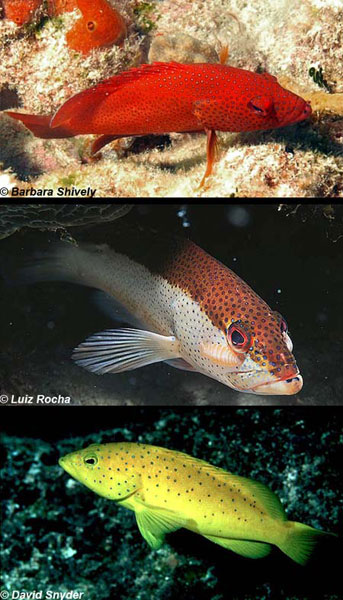
Size, Age, and Growth
The maximum reported size of the coney is 16 inches (41.0 cm) total length (TL) with maturity being attained at a fork length of 6 inches (16.0 cm). The maximum reported lifespan of this species is 11 years.Food Habits
The coney feeds primarily on small fishes including Cantherhines pullus, Monacanthus tuckeri, Sphoeroides sp.,Aulostomus maculatus, and Acanthurus sp. It also feeds on invertebrates such as crabs and shrimps. Occasionally this species will follow moray and snake eels to feed on prey flushed from the reef.
Reproduction
As a protogynous species, female coneys mature at 6 inches (16 cm) TL and transform into males at about 8 inches (20 cm) TL. There appears to be a seasonal peak for spawning. In Bermudian waters, the peak months are from May through August while off Jamaica, spawning occurs during January through June. In the Bahamas, coneys spawn in December and January. Spawning activity occurs just prior to sunset over a period of several days with the males spawning daily with each of the females within his harem. Each female releases 150,000 to 282,000 eggs with each spherical egg measuring 0.04 inches (0.95mm) in diameter and possessing a single oil globule. Males appear to be territorial. There have been a few individuals reported as appearing to be hybrids of the coney and the Atlantic creolefish, Paranthias furcifer.
Parasites
Documented parasites of the coney include the trematode Opechona orientalis from off the coast of Brazil and the copepods Sagum flagellatum, Lepeophtheirus dissimulatus, and Hatschekia serrana. Digeneans parasitizing the coney include Cainocreadium lintoni, Gonapodasmius sp., Hamacreadium mutabile, Helicometrina nimia, Neolepidapedon equilatum, Opecoelus mexicanus and Stephanostomum casum. Isopod parasites found on the coney include Cymothoa oestrum and Gnathia sp. Other parasites include Lecithochirium microstomum (fluke) and Pseudorbdosynochus kritskyi (metazoan).
Predators
Predators of the coney include larger bony fish such as the Nassau grouper (Epinephelus striatus) as well as sharks.
Taxonomy
The coney was originally described as Cephalopholis fulva by Linnaeus in 1758. Synonyms referring to this member of the Serranidae include Epinephelus fulva Linnaeus 1758, Epinephelus fulvus Linnaeus 1758, Perca punctata Linnaeus 1758, Labrus fulvus Linnaeus 1758, Holocentrus auratus Bloch 1790, Bodianus guativere Bloch & Schneider 1801, Gymnocephalus ruber Bloch & Schneider 1801, Serranus carauna Valenciennes 1828, and Serranus ouatalibi Valenciennes 1828.
Prepared by: Cathleen Bester